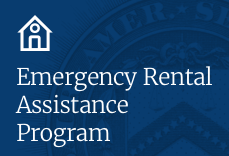
Data Update: Rental Assistance Need and Federal ERA Allocation in New York State

The Covid-19 pandemic has resulted in lay-offs, closed businesses, and financial distress for hundreds of thousands of Americans. In a previous analysis, we showed how the economic impact was disproportionely falling on low-income renters. It is therefore critically important that policymakers understand the geographic distribution of renter need in order to best allocate rental assistance funds. There are 482,000 renter households statewide who lost wages as a result of the pandemic, requiring an estimated $233M of rental assistance every month to return to their pre-pandemic housing cost burdens. (Read more about our methodology.)
All code and data for our analysis of rental assistance need are available on GitHub.
Last December’s stimulus package from the federal government provided much-needed federal resources for rental assistance, however the method for allocating the funding across states and cities is key for ensuring a fair distribution of the limited funds. The stimulus package extended the eviction moratorium for one additional month, and provided $25 billion in rental assistance to states and localities through the Emergency Rental Assistance Program. Localities with populations of at least 200,000 can apply to the Treasury Department for direct assistance, which will be allocated according to a formula based on population share. However, direct assistance is limited to 45 percent of the localities’ population share, well short of potential need. The remaining federal funds will be left to the state to distribute.
Even a population-based methodology for providing funds does not necessarily match with the distribution of local needs. Other metrics to be considered are the share of renters and the share of renters economically impacted. It is important for policymakers to consider this data in order to ensure that the stimulus packages and programs meant to help the most vulnerable populations are actually reaching these individuals.
| Estimated local share of statewide totals for largest NY cities and counties | ||||
|---|---|---|---|---|
| Share of Total NYS Aid Direct from Fed Gov't | Share of NYS Population | Share of NYS Renter Households | Share of Estimated Need¹ | |
| City | ||||
| Albany | 0.2% | 0.5% | 0.8% | 0.6% |
| Buffalo | 0.6% | 1.3% | 1.9% | 0.7% |
| New York City | 19.4% | 43.1% | 63.2% | 75.3% |
| Rochester | 0.5% | 1.0% | 1.6% | 0.7% |
| Syracuse | 0.3% | 0.7% | 1.0% | 0.5% |
| Yonkers | 0.5% | 1.0% | 1.2% | 1.0% |
| County | ||||
| Albany | 0.7% | 1.5% | 1.6% | 1.0% |
| Dutchess | 0.7% | 1.5% | 1.0% | 0.8% |
| Erie | 2.1% | 4.7% | 4.1% | 1.6% |
| Monroe | 1.7% | 3.8% | 3.3% | 1.5% |
| Nassau | 3.2% | 7.1% | 2.5% | 3.5% |
| Niagara | 0.5% | 1.1% | 0.8% | 0.3% |
| Oneida | 0.4% | 0.8% | 0.7% | 0.2% |
| Onondaga | 1.0% | 2.2% | 1.8% | 0.9% |
| Orange | 0.9% | 2.0% | 1.3% | 0.8% |
| Rockland | 0.8% | 1.7% | 0.9% | 1.0% |
| Saratoga | 0.5% | 1.2% | 0.7% | 0.4% |
| Suffolk | 3.5% | 7.7% | 2.7% | 3.5% |
| Westchester | 2.2% | 5.0% | 3.9% | 4.3% |
| Sources: US Census American Community Survey 2019 via IPUMS USA, US Bureau of Labor Statistics (BLS) Current Employment Statistics (CES) | ||||
| ¹Unemployment estimates use change between Nov 2019 and Nov 2020 by industry for NYS. For more details on methodology for estimated rental assistance need, see our previous blog post | ||||
The first column in the table above shows the share of direct federal aid that various cities and counties of at least 200,000 will receive from the federal government. The second column shows the population share each of these cities represent. The third column shows the share of statewide renter households located in each jurisdiction, while the fourth shows the estimated total share of rental assistance need.
The data show there is a larg gap between the population of rental households and rental assistance need in some parts of the state, including Manhattan and Westchester. In New York City, the share of rental assistance need (75.2 percent) is higher than the share of renter households with lost wages (64 percent).
One reason for this difference may be the higher housing and rental costs in these areas. It may also result from a concentration of renters in vulnerable industries in those cities. For example, New York City is likely to have a larger share of entertainment or hospitality workers, many of whom have lost their positions during the pandemic. Government aid is needed to balance out these disparities and help areas, like New York City, with the greatest percentage of rental assistance need.
Look at other cities such as Buffalo, we can see that the city makes up only 1.3 percent of New York state households, but accounts for 1.9 percent of the state's renters. But factors like lower housing costs in Buffalo mean they only account for 0.8 percent of the state's rental assistance need as a share of total dollars needed. The rental assistance need of renters in Buffalo is therefore more closely aligned with their share of the population than other parts of the state.
In devising programs to fairly allocate federal rental assistance funding, the state should consider the distribution of renters and more importantly, the distribution of need, specifically in light of the direct payment to localities being only 45 percent of their population share.
(All code and data for our analysis of rental assistance need are available on GitHub.)


